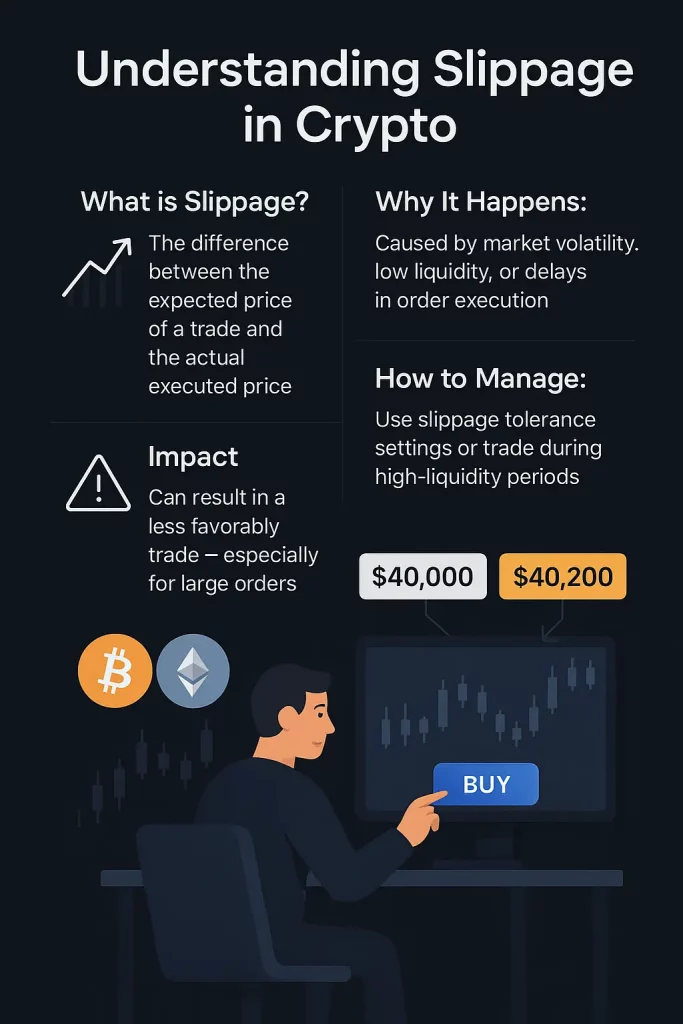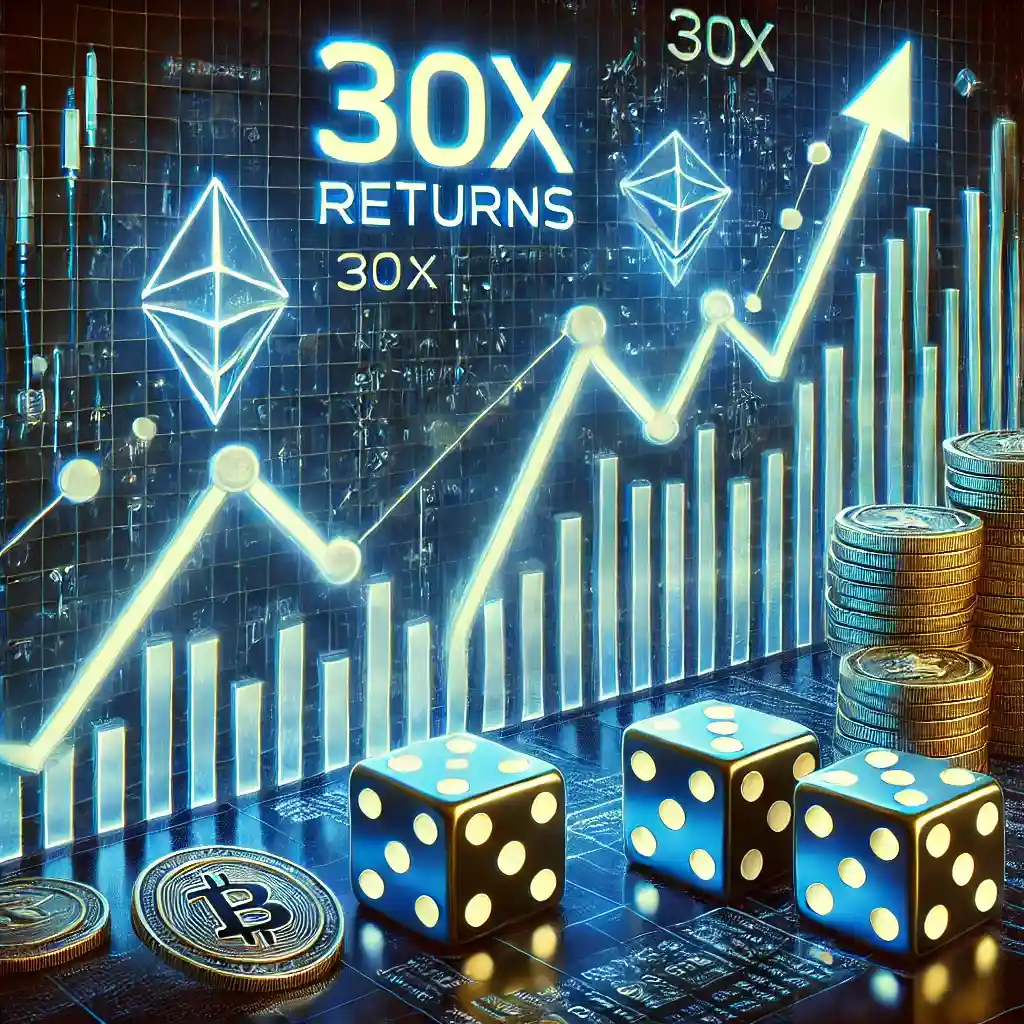Understanding and Minimizing Slippage in Crypto Trading
Cryptocurrency trading is an exciting yet challenging space, where split-second decisions can make or break your profits. One key challenge you’ll face is slippage a phenomenon that can unexpectedly affect your trade outcomes. Whether you’re swapping tokens on Uniswap or trading Bitcoin on Binance, understanding slippage is essential for optimizing your strategy. In this comprehensive guide, we’ll break down what slippage is, how it works across wallets and exchanges, its causes, impacts, real-world examples, and practical ways to minimize it. By the end, you’ll have the tools to navigate slippage confidently and trade smarter.

What is Slippage in Crypto?
Slippage in crypto trading refers to the difference between the price you expect when placing a trade and the price at which it actually executes. This discrepancy arises due to the fast-moving nature of crypto markets and the mechanics of trading platforms, particularly decentralized exchanges (DEXs) that use Automated Market Makers (AMMs).
Defining Slippage
You want to buy a token at $100, but by the time your trade goes through, the price has shifted to $101. That $1 difference per token is slippage, calculated as:
Slippage (%) = [(Executed Price – Expected Price) / Expected Price] × 100
Slippage can be:
Positive Slippage: You get a better price than expected (e.g., buying at $99 instead of $100).
Negative Slippage: You get a worse price (e.g., buying at $101), which is more common and what traders aim to avoid.
Why Slippage is Common in Crypto
Crypto markets are highly volatile, with prices often swinging dramatically within minutes. This volatility, combined with the structure of DEXs, makes slippage more pronounced than in traditional markets. Unlike centralized exchanges (CEXs) with deep order books, DEXs rely on liquidity pools managed by AMMs, such as Uniswap or PancakeSwap. These pools have finite liquidity, and large trades can significantly alter the price, leading to slippage.
For example, in an AMM, the price is determined by the ratio of two assets in a liquidity pool using a formula like x * y = k. If you trade a large amount relative to the pool’s size, you’ll shift this ratio, causing the price to move against you.
Slippage in Crypto Wallets and Exchanges
Slippage behaves differently depending on whether you’re trading through a wallet or an exchange, and whether it’s centralized or decentralized.
Slippage in Wallets
Crypto wallets like MetaMask or Trust Wallet allow you to interact directly with DEXs. When you initiate a swap, you’ll encounter a “Slippage Tolerance” setting. This lets you define the maximum price deviation you’re willing to accept. For instance:
- If you set a 1% slippage tolerance, your trade will only execute if the price stays within 1% of the quoted price.
- If the price moves beyond this, you’ll see an error like “slippage tolerance exceeded,” and the transaction will fail, protecting you from unfavorable prices.
Centralized Exchanges
On CEXs, slippage is generally lower due to deeper liquidity and sophisticated order-matching systems. However, it can still occur with:
- Market Orders: These execute immediately at the best available price, which can vary in volatile markets.
- Limit Orders: These allow you to set a specific price, reducing slippage by ensuring the trade only happens at your desired price.
Decentralized Exchanges
DEXs, powered by AMMs, are more prone to slippage because trades directly affect the liquidity pool’s asset ratio. For example, if you’re swapping ETH for a less liquid token on Uniswap, a small pool might mean your trade significantly impacts the price, leading to higher slippage. Popular pairs like ETH/USDT typically have larger pools, reducing slippage for smaller trades.
Key Takeaway: Wallets and DEXs require careful slippage management due to their reliance on liquidity pools, while CEXs offer more stability but aren’t immune to slippage during volatility.
What is Slippage Tolerance?
Slippage tolerance is a customizable setting on DEXs that lets you control how much price movement you’ll accept before a trade fails.
Defining Slippage Tolerance
Expressed as a percentage (e.g., 0.5%, 2%), slippage tolerance sets the maximum allowable difference between the quoted price and the executed price. If the price moves beyond this threshold, the trade is canceled. For example:
A 1% tolerance means your trade will only go through if the price is within 1% of what you expected.
If you set a 2% slippage tolerance for a $100 token, the trade will fail if the price moves to $102 or higher.
Common Slippage Tolerance Settings
0.5%: Best for stable markets or highly liquid pairs like ETH/USDT.
1-2%: A balanced choice for most traders, offering flexibility without excessive risk.
5% or higher: Used for volatile or illiquid tokens, but increases exposure to unfavorable prices.
What is Max Slippage?
Max slippage refers to the highest tolerance you’re willing to set. A high max slippage (e.g., 10%) ensures your trade executes even if the price moves significantly, but it risks executing at a much worse price. Conversely, a low max slippage protects your profits but may lead to failed trades in volatile conditions.
Pro Tip: Start with a 1-2% tolerance and adjust based on the token’s liquidity and market volatility. For less liquid tokens, you may need a higher tolerance to avoid repeated transaction failures.
Causes of Slippage in Crypto
Slippage isn’t random it’s driven by specific market and platform factors. Understanding these causes helps you anticipate and manage it.
Key Causes
1. Market Volatility
Crypto prices can swing rapidly due to news, market sentiment, or large trades by “whales.”
Example: You place a buy order at $100, but a sudden price surge to $105 results in negative slippage.
2. Low Liquidity
Small liquidity pools on DEXs or thin order books on CEXs mean even modest trades can move prices.
Example: A $1,000 trade in a $10,000 pool can significantly shift the price, causing slippage.
3. Large Order Sizes
Big trades relative to available liquidity deplete pools or order books, pushing prices against you.
Example: Buying $5,000 of a low-liquidity token may increase the price mid-trade.
4. Network Congestion
On blockchains like Ethereum, high gas fees or slow confirmations can delay trades, allowing prices to change.
Example: A delayed transaction during a price spike can lead to slippage.
5. Price Movement Exceeds Slippage Tolerance
If your tolerance is too low for current market conditions, trades may fail, requiring you to adjust settings or wait for stability.
Causes of Slippage and Their Impact
| Cause | Description | Impact on Slippage |
|---|---|---|
| Market Volatility | Rapid price changes due to news or sentiment | Increases slippage, especially in DEXs |
| Low Liquidity | Small pools or thin order books can’t absorb large trades | Higher slippage for even small trades |
| Large Order Sizes | Big trades significantly alter pool ratios or order book depth | Amplifies price movement, increasing slippage |
| Network Congestion | Delays in blockchain confirmation allow prices to shift | Leads to unexpected price changes |
| Low Slippage Tolerance | Strict settings cause trades to fail if price moves beyond threshold | Prevents execution, requiring adjustments |
Impact of Slippage and Tolerance Thresholds
Slippage can significantly affect your trading outcomes, and your slippage tolerance settings play a critical role in managing this impact.
What Happens If Slippage Is Too High?
- For Buyers: You pay more than expected, reducing potential profits or increasing losses.
- For Sellers: You receive less than anticipated, cutting into your returns.
- Long-Term Effect: Frequent high slippage can erode profits, especially for high-volume traders.
For example, if you buy a token at $100 expecting it to rise to $110, but slippage pushes your purchase price to $105, your profit margin shrinks, and a smaller price increase might result in a loss.
Is Higher or Lower Slippage Better?
Lower Slippage Tolerance: Protects against unfavorable prices but risks failed trades in volatile markets. Ideal for stable, liquid assets.
Higher Slippage Tolerance: Ensures trades execute but increases exposure to adverse price movements. Useful for illiquid or volatile tokens.
Scenario Comparison:
0.5% Tolerance: You’re trading ETH/USDT during low volatility. The trade executes close to the quoted price, but if volatility spikes, it may fail.
5% Tolerance: You’re trading a low-liquidity token. The trade goes through, but you might pay significantly more than expected.
Key Takeaway: Balance your slippage tolerance based on market conditions and your risk appetite. A 1-2% tolerance is often a safe starting point.
Examples of Slippage in Crypto
Real-world examples clarify how slippage affects trades across different platforms.
| Platform | Scenario | Expected Price | Executed Price | Slippage Outcome |
|---|---|---|---|---|
| Uniswap (DEX) | Swap 1 ETH for USDC | 2000 USDC | 1990 USDC | Negative (10 USDC less) |
| Binance (CEX) | Buy 10 BTC with market order | $50,000 | $50,001 | Minimal negative slippage |
| Any Platform | Buy during news-driven price drop | $98 | $93 | Positive ($5 better) |
How to Avoid or Minimize Slippage
While slippage is inevitable in crypto trading, you can take steps to reduce its impact and protect your profits.
Strategies to Minimize Slippage
Use Limit Orders: Specify exact buy/sell prices to avoid executing at unfavorable rates.
Example: Set a limit order to buy BTC at $50,000 instead of a market order.
Trade During Low-Volatility Periods: Crypto markets often have calmer periods (e.g., overnight UTC). Check historical data to identify these windows.
Choose High-Liquidity Pairs: Trade pairs like BTC/USDT or ETH/USDT, which have deep liquidity pools or order books.
On DEXs, select pools with large reserves to minimize price impact.
Set Appropriate Slippage Tolerance: Use 1-2% for most trades, adjusting higher for illiquid tokens or volatile markets.
Monitor and tweak settings to avoid frequent transaction failures.
Avoid Major News Events: News-driven volatility can spike slippage. Use limit orders or wait for stability if trading during such times.
Leverage Trading Bots: Automated tools can execute trades faster, reducing the time between order placement and execution.
Key Takeaway: Combining these strategies limit orders, high-liquidity pairs, and smart timing helps you manage slippage effectively.
Conclusion
Slippage is a natural part of crypto trading, driven by the market’s volatility and the mechanics of platforms like DEXs and CEXs. By understanding its causes, setting appropriate slippage tolerances, and using strategies like limit orders and high-liquidity trading, you can minimize its impact and improve your trading outcomes. Stay proactive, monitor market conditions, and adjust your approach to navigate slippage like a seasoned trader.

